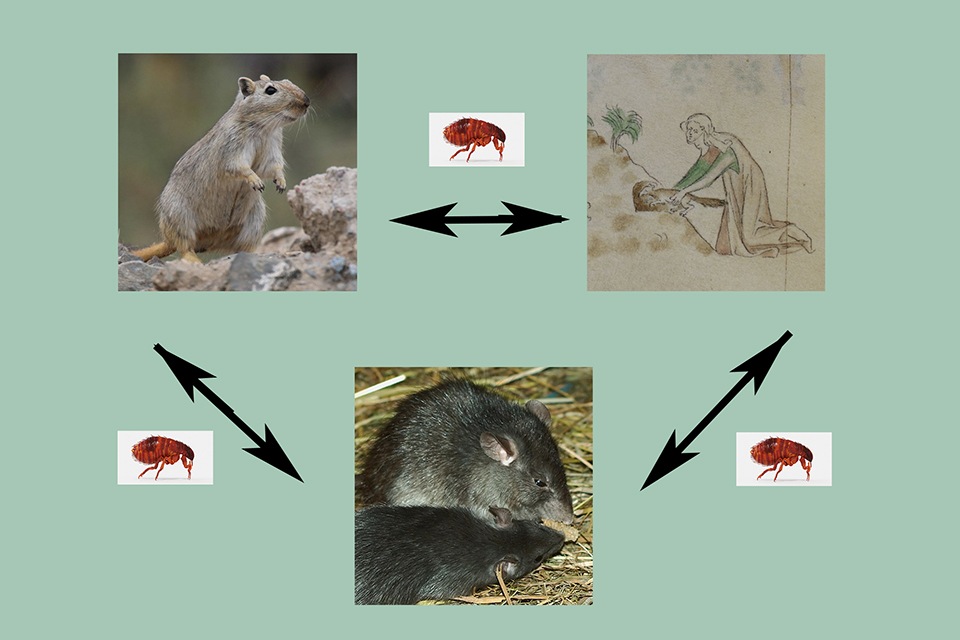Recent studies of aDNA have yielded new and important information concerning the natural and clinical history of plague. A new comprehensive review offers an up-to-date history
The plague is caused by a zoonotic bacterium, Yersinia pestis. First isolated in 1894, it was identified as the cause of the Hong Kong Epidemic. Later, in the 20th century, the same bacterium was shown to have caused the Black Death. Recently – due to studies of the aDNA – the same bacterium has been shown to have caused the Justinian plague as well as very recently epidemic events in prehistory 2800 BC. Also – which the article does not refer to – the discovery of the likely role of a plague epidemic following in the footsteps of the Yamnaia.
During its natural history, the pathogen has undergone numerous mutations at different rates, transforming it from a variant of Yersinia pseudotuberculosis to more or less virulent Yersinia Pestis, traditionally divided into three bio-variations termed the Antiqua, the Medievalis, and the Orientalis – named after three major epidemics, the Justinian Plague, The Black Death, and the Hong Kong epidemic. The three variants may still be found in reservoirs in respectively Central Asia, Siberia and Russia (the Antiqua), Central Asia (the Black Death), and China (Orientalis). However, the biotypes intermingled – also historically. To this should be added the knowledge, that the bacterium mutated while the different waves of an epidemic played out.
Transmission
Transmission to humans from carriers typically happens via flea bites, but it can also follow through direct contact with infected animals for instance by handling or eating them, or by inhaling aerosols from patients. Modern incidents tell of infections from squirrels, but also via predators infected from carcasses (Pumas in Yellowstone). Plague comes in three forms – bubonic, septicemic and pneumonic. While people can survive bubonic plague, the septicemic and pneumonic forms are 90-100% deadly.
Yersinia Pestis is a highly virulent pathogen known to infect over 200 different mammals. Of these, more than 351 species of rodents can act as hosts, and 279 have been identified as plague carriers. Thus, the former focus among historians on the rat as the main vector would seem to be excessive. Marmots may have played a significant role in the northern parts of Europe, causing the epidemics known as the Sylvatic or (wild) plagues spreading among groundhogs, great gerbils, squirrels, prairie dogs, rabbits, and water voles. Although human contact may at first sight be expected to be rare, hunters and trappers in Siberia and further west into Scandinavia, would historically be daily exposed, thus explaining the heavy toll that the Black Death also had in secluded spots in Norway and Sweden (as well as during the Justinian plague in Bavaria). Today, the so-called wet markets in China and Asia are not just potential petri dishes for viruses like Covid but also plagues.
As opposed to the Sylvatic plagues, the Urban form is epidemic and relies on rats as the hosts and fleas as the vectors. However, the epidemic character of the urban plague has also to do with the fact that written documentation describes them as such. As opposed to this, the sylvatic form is only known from archaeology and paleo-genomics, leading to a more confused impression, such as the puzzlement forged by the pattern of infections and mortality in Norway (with no particular black rat population in the interior, see Benedictow).
Exactly how lethal the different plagues hit, has been debated. Currently, though, the opinion is that the plagues hit hard, albeit at different levels in different regions and types of settled areas, ranging – during the Black Death – between 30 – 50% with averages of 45%. The recurrent infections also raise questions which need to be addressed in the future. As is known, the Black Death was not just a one-off epidemic hitting Europe harshly between 1348-51. For at least 350 years, outbreaks continued. Were they sourced in natural reservoirs? Or did they take place due to the constant mutations of the bacterium and its ability to bypass the developing immune system of people?
One particular element to be considered in the future (and which the review does not consider) will be the interplay between climate deterioration and the four great plagues. The plague victims discovered in graves from 3000-2800 BC, played out during the so-called neolithic decline when a unique combination of solar activity, cosmic rays and decentering of the geomagnetic fields. This might be compared to the chronological correspondence between the volcanic-forced LALIA AD 536-41 and the Justinian plague. Finally, the climate downturn took off in the later Middle Ages ultimately leading to the Little Ice Age. The mechanism appears to be the increase in the number of rodents caused by warm and wet conditions. Followed by less favourable climatic conditions, these rodent populations collapse, forcing the fleas to migrate to other mammals; that is people.
SOURCE:
The Natural and Clinical History of Plague: From the Ancient
Pandemics to Modern Insights
Antoni Bennasar-Figueras
In: Microorganisms, January 2024. Open Source
Antoni bennasar-Figueras is professor in Biology at Universitat de les Illes Balear
READ ALSO:
Emergence and Spread of Basal Lineages of Yersina pestis during the Neolithic Decline
By Nicolas Rascovan, Karl-Goöran Sjögren, Kristian Kristiansen, Rasmus Nielsen, Eske Willerslev, Christelle Desnues, Simon Rasmussen
In: Cell 2019, vol 176, pp 295 – 305
